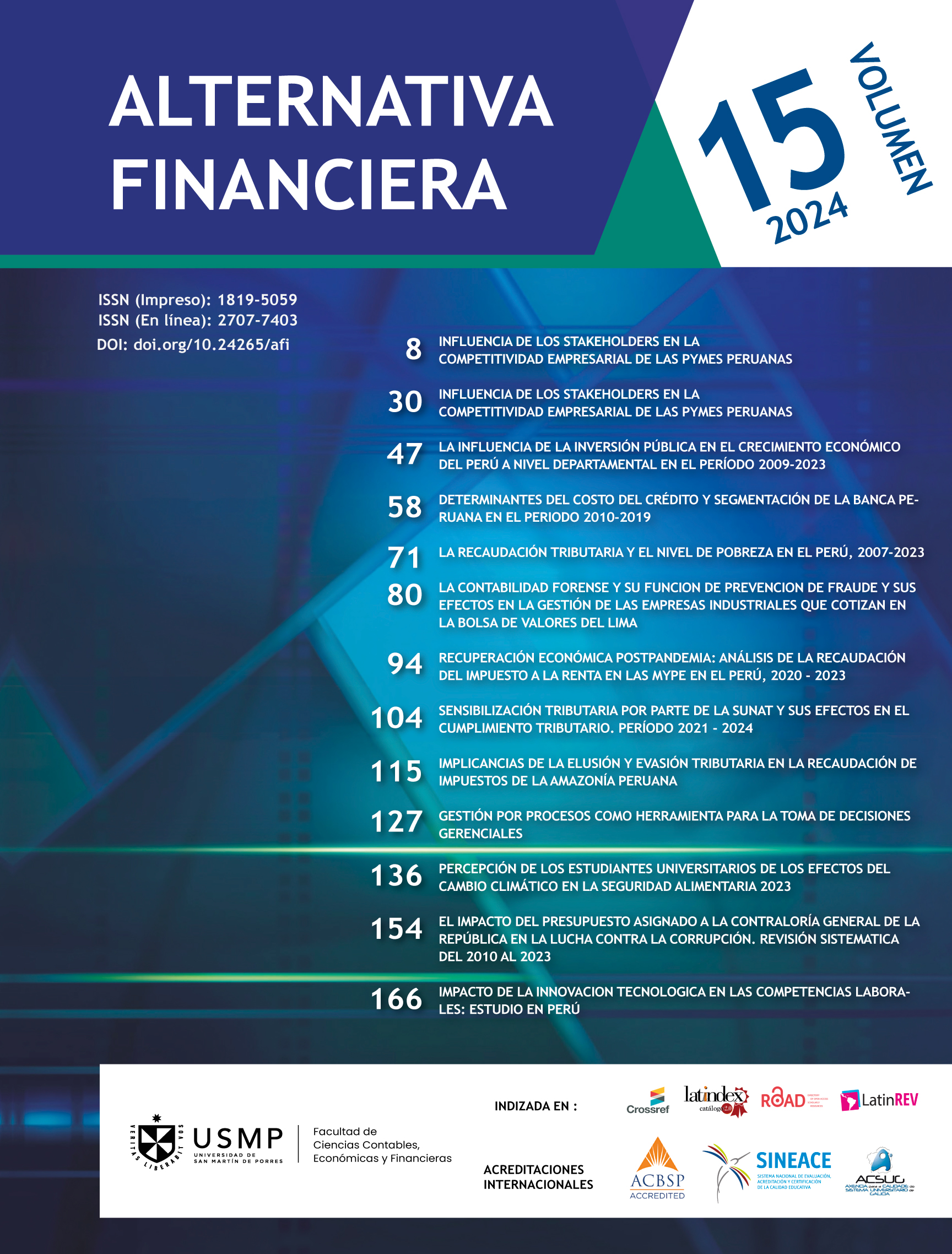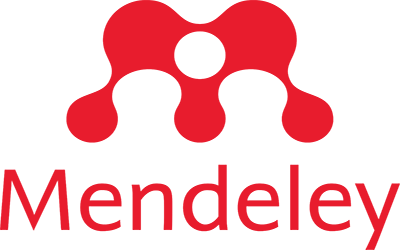FORENSIC ACCOUNTING AND ITS FRAUD PREVENTION FUNCTION AND ITS EFFECTS ON THE MANAGEMENT OF INDUSTRIAL COMPANIES LISTED ON THE LIMA STOCK EXCHANGE
Keywords:
contabilidad forense, prevención de fraude, gestión empresarial, prevención, control, criminología, funciones contables, empresas industrialesAbstract
The present research work called Forensic accounting and its fraud prevention function and its effects on the management of industrial companies listed on the Lima Stock Exchange, in which fraud prevention is identified as one of the main problems within the management of the company resulting in a potential loss of money, prestige, among others; This part of accounting control is not yet well defined, its concepts, functions and objectives, which is why our work contributes to the knowledge of this subject.
The objective of this research is to demonstrate that occupational fraud can be prevented in real time through a Methodical and structured control system led by the accounting department, and this in turn by the forensic accountant as long as he has the skills, tools, and sufficient disciplines to be able to assume said preventive function.
The focus of the research is on the various measurements related to the elements of vulnerability of the management of the company in which there is a series of operations that may result in a high risk of committing an occupational crime, therefore It should be within the company that the accounting professional should have the main function of controlling and protecting the company’s assets, through disciplines which are not traditional but are essential in current times. These tools are data mining, data management, big data, risk mapping, the use of red flags, criminology, criminology and documentology, etc.
The methodology used for the research meets the conditions to be called applied since the scope of the research occurs in factual and exploratory reality since it allows us to identify the object of study, non-experimental observational, quantitative and qualitative correlational, as well through surveys carried out with accountants of industrial companies of companies listed on the Lima stock exchange as well as structured interviews with experts on the subject.
In conclusion and after having carried out the corresponding comparisons; The proposed hypothesis was demonstrated, thus we have that effectively the forensic accountant can and must carry out quantitative and qualitative measurements and report in the shortest possible time to management on the risks of fraud, likewise the accounting professional
must be prepared to be able to assume new forms of supervision.
KEYWORDS: Forensic accounting, fraud prevention, business management, prevention, control, criminology, accounting functions, industrial companies.
Downloads
References
Association of Certified Fraud Examiners (ACFE) (2022) www.acfe.com
Bello (2001). La prevención del fraude y el control en el servicio público de Nigeria: La necesidad de un enfoque dimensional. Journal of Administration de Empress, 1 (2), 118-133
Bellman, R. (1978). An introduction to artificial intelligence: Can computers think? Thomson Course Technology
Benítez Palma, E.J., (2020) «El control externo del gasto público en el Estado automatizado», Revista Española de Control
Externo, vol. XXII, No. 65, , p. 109.
Bhasin, M. (2007). Contabilidad forense: Un nuevo paradigma para el nicho de consultoría El censor jurado de cuentas, El País. 18
Campos Acuña, M.C., (2022) «La tecnología al servicio de la ética pública: IA, data mining y otras disrupciones en los sistemas de integridad», Revista española de control externo, vol. XXIV, No. 72, setiembre p.75
Contreras A. L. (2004). Los delitos económicos relacionados con la corrupción. Santiago de Chile, Editorial La Aurora. 45
Castañeda G. L. (1982) Fraudes en las empresas industriales. Tesis Facultad de Ciencias Económicas. Universidad de San Carlos de Guatemala. p.14
Carrasco D. S., 2006, Metodología de la investigación científica. Perú: Editorial San Marcos. 41
Degboro, D., y Olofinsola, J. (2007). Contadores forenses y el compromiso de apoyo de pleito. Nigeriana Contador. 49
Dickey, G., Blanke, S., Seaton, L(2019).: «Machine Learning in Auditing. Current and Future Applications», CPA Journal, https://www.cpajournal.com/2019/06/19/machinelearning-in-auditing
Elliot, A. L y Schroth R. (2000), Cómo mienten las empresas. Barcelona: Gestión.com, 2003. 51-56
Gunasegaran M. (2010) Trabajo de investigación La intención organizacional de utilizar los servicios de contabilidad forense para la prevención y detección de fraude BY LARGE MALAYSIAN COMPANIES por las empresas grandes de Malasia. 12-98
Harris, J.M. (2010). The Macroeconomics of Development without Through put Growth. Tufts University Global development and Environment Institute Working Paper, 145
Hernández S., Fernández C., y Baptista L., (2006). Concepción o elección del diseño de investigación. En: R. Hernández Sampieri, C. Fernández Collado y P. Baptista Lucio. Metodología de la investigación 4a edición. México, D.F.: McGraw-Hill. 117-160
La Rosa, (1996) María Edelmira García La Rosa Proyecto de investigación EL juego de Ciencia Editores, 2
Kerlinger (2002). Investigación del comportamiento. Métodos de investigación en ciencias sociales. 4ta. ed. México: Mc Graw Hill. 167
Kokina, J., Davenport, T. H., (2017) «The Emergence of Artificial Intelligence: How Automation Is Changing Auditing » Journal of Emerging Technologies in Accounting, primavera de 2017, http://bit.ly/2Heshyk.
Krstić J. (2009) Tesis El papel de los contadores forenses en detección FRAUDS IN FINANCIAL STATEM fraudes en los estados financieros. 26 -91
KPMG (2021) https://home.kpmg.com/pe/es/home.html
Kurzweil, R., Richter, R., Kurzweil, R. y Schneider, M. L. (1990). The age of intelligent machines (Vol. 579). Cambridge: MIT press
Mantilla, S. A. (2010) Auditoría Financiera De Pymes, Colombia, Ecoe Ediciones (2007) 337
Malhotra N. K. (2005) Malhotra, Investigación de mercados con enfoque práctico. México: Prentice Hall. 90
McKendall M, DeMarr B., y Rikkers C. J. (2002). Ethical Compliance Programs and Corporate Illegality: Testing the Assumptions of the Corporate Sentencing Guidelines. Journal of Business Ethics 37(4) 367-38
Nigrini, M (2011). “Analytics Forenses: Métodos y Técnicas para la Contabilidad Forense. 13
Nelson Andrew (1992). “Introducción a la intervención de cuentas”. Unión Tipográfica Hispanoamericana. 56
Prasad Dotel, R., (2020). «Inteligencia Artificial: Preparación para el futuro de la auditoría», International Journal of Government Auditing, cuarto trimestre, 2020.
https://intosaijournal.org/es/journal-entry/artificial-intelligencepreparing-for-thefuture-of-audit/
Singleton, TW, y Singleton, AJ (2010). Auditoría de Fraude y Contabilidad Forense, (3ª ed.).New York: John Wiley & Nueva York: John Wiley & Sons. 134
Soberanis A., Rueda M. y Herrera F. E. (2013) La auditoría interna en la detección y prevención de fraudes. Conferencia interamericana de contabilidad trabajo nacional Guatemala. 15
Williams, JW (2002). Reproducción de la Shell Corporativa Juego: La Contabilidad Forense e investigación industrial, Derecho, y la dirección de partidos de organización. Disertación Doctoral, Toronto: Universidad de York. 29-3
Nunnally, J.C. (1978), Psychometric theory. 2nd Edition, McGraw-Hill, New York. 245-246
Selltiz, C. (1980), Métodos de Investigación en Relaciones Sociales, Novena edición Editorial RIALP SA Madrid, 39
Sánchez, (2018). Manual de términos en investigación científica, tecnológica y humanística. Primera Edición Bussiness
Support Aneth S.R.L. Lima _ Perú. 33
Tamufor N.M. (2010) Evaluación de la práctica actual de auditoría y contabilidad forense fraude en Camerún 26-58
Werbos P.J. (2009). Intelligence in the brain: A theory of how it works and how to build it. Neural Networks, 22, 3, 200-212
Downloads
Published
Issue
Section
License
Copyright (c) 2024 Guillermo Merino Hurtado

This work is licensed under a Creative Commons Attribution-NonCommercial-ShareAlike 4.0 International License.
Creative Commons Atribución-NoComercial-CompartirIgual 4.0 Internacional (CC BY-NC-SA 4.0). Faculta a los usuarios a compartir: copiar y redistribuir el material en cualquier medio o formato y adaptar: remezclar, transformar y desarrollar el material, siempre y cuando se acredite al autor original, no se utilice con propósitos comerciales y las nuevas creaciones se licencien bajo los mismos términos de esta licencia.













